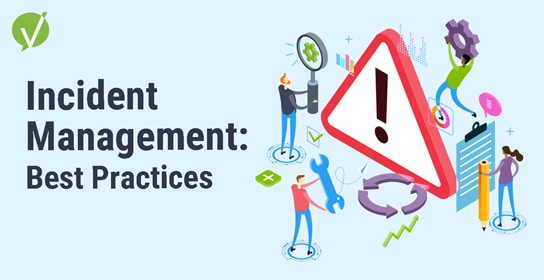Incident Management Best Practices: Streamlined Operations Guide
Introduction
Incident management best practices is the backbone of a seamless IT support operation, but it’s not just about resolving issues – it’s about doing it efficiently and effectively. In this article, we’ll walk you through essential incident management best practices, offering valuable insights and real-world examples. Whether you’re an IT professional, manager, or decision-maker, this streamlined guide will equip you with the knowledge to optimize your incident resolution strategy.
10 Best Practices to Improve Incident Management
Welcome to the world of incident management best practices, where we’ll explore the most effective strategies to elevate your IT support game. Even if you consider yourself an incident resolution expert, staying ahead of trends is crucial. We’ll draw inspiration from the “10 Best Practices to Improve Incident Management” and take a deeper dive into these practices with actionable insights and practical examples.
1. Defining Incidents for Your Organization
In the world of incident management, clarity is key. Start by defining what constitutes an “incident” for your organization. For instance, in the healthcare industry, an incident might involve a patient data breach, while in e-commerce, it could be a website outage during peak shopping hours. The key is aligning the definition with your industry and business goals.
2. Assembling the A-Team: Key Skills for Incident Management
Building your incident response team is like assembling a winning sports lineup. In healthcare, you might need IT specialists well-versed in patient data security regulations like HIPAA. Similarly, the financial sector may require experts in fraud detection and prevention. Regardless of your industry, hiring individuals with specific skills tailored to your needs is vital.
3. Streamlining Efficiency: The Magic of Incident Automation
Let automation do the heavy lifting. In the retail sector, during high-demand sales events like Black Friday, automated incident assignment ensures that critical issues like website crashes are swiftly directed to the right IT professionals. Automation tools can even handle routine tasks, such as password resets, freeing up valuable time in industries like education.
4. Communication Channels: Bridging the Support Gap
In hospitality, offering diverse communication channels like phone, email, and live chat ensures guests can report issues seamlessly. For manufacturing, integrating IoT devices for incident reporting provides real-time insights into machinery breakdowns. Tailor your channels to suit your industry’s unique demands.
5. Keeping Everyone in the Loop: Timely Updates Matter
In aviation, where passenger safety is paramount, real-time updates on flight delays due to technical issues are crucial for both airline staff and passengers. Similarly, in the legal sector, attorneys rely on timely notifications for uninterrupted case proceedings. Industry-specific examples highlight the importance of regular updates.
6. Updating Your Knowledge Base for Incident Resolution
In the energy sector, technicians need quick access to troubleshooting guides for complex machinery. A well-structured knowledge base ensures they find the right information swiftly. Likewise, in the fashion industry, customer support teams can benefit from easily accessible product information to handle inquiries efficiently.
7. Diving Under the Surface: Mastering Root-Cause Analysis
The automotive industry faces recalls due to safety concerns. Conducting root-cause analysis helps identify manufacturing flaws, preventing recurring incidents. In the food industry, understanding the root causes of contamination incidents is vital for product safety. Root-cause analysis is industry-agnostic and applies to various sectors.
8. Training for Excellence: Empowering Your IT Support Team
In the tech sector, IT professionals need up-to-date cybersecurity training to combat evolving threats. In education, IT support staff require training on the latest e-learning platforms. Tailoring training to industry-specific needs ensures your team is well-prepared.
9. Test, Review, and Refine: Preparing for the Unexpected
In the telecommunications industry, rigorous testing before a network launch ensures seamless connectivity. While in healthcare, testing electronic health record systems helps prevent critical patient data errors. Testing and review are industry standards to guarantee reliable operations.
10. Building a Culture of Support and Continuous Improvement
Creating a supportive culture is essential in industries like social services, where support staff deal with vulnerable populations. In the gaming industry, fostering a culture of continuous improvement is crucial for ongoing success. Regardless of your field, a positive support culture is a common thread for excellence.
Exploring Incident Management Workflow & Activities
As you embark on your journey of implementing these best practices, it’s essential to grasp the foundational aspects of incident management. Incident management is not a linear process; it’s a dynamic workflow comprising various activities. These activities are the core components that keep your incident resolution engine running smoothly. Understanding the sequence and significance of these activities is vital for implementing the strategies effectively. So, let’s start by exploring the incident management workflow and the key activities that make it tick.
- Sequence is Key: The order in which incident management activities occur is not arbitrary; it’s a carefully structured sequence designed to ensure efficient issue resolution.
- Significance of Each Step: Every activity within the incident management workflow holds a distinct purpose, contributing to the overall success of incident resolution.
- Optimizing Efficiency: By understanding the sequence and significance of these activities, organizations can streamline their incident management processes, reducing response times and minimizing service disruptions.
- Enhancing Communication: Effective incident management hinges on clear communication between IT teams, stakeholders, and end-users, which is facilitated through the structured workflow.
- Data for Improvement: The incident management workflow generates valuable data that can be used to assess performance, identify recurring issues, and make data-driven improvements.
- Continuous Learning: A thorough understanding of these activities allows organizations to foster a culture of continuous learning and adaptation, ensuring that they remain agile in responding to evolving challenges.
Unleash Your IT Support Potential
In the realm of IT support, mastering incident management best practices isn’t just a way to resolve issues—it’s the key to unlocking a world of operational excellence. By embracing these strategies, your organization can ensure that incidents are not roadblocks but rather stepping stones towards growth and improvement. Remember, each incident presents an opportunity to refine your processes, elevate your team’s capabilities, and ultimately, provide a superior support experience. So, dive into the world of incident management best practices, and let excellence become your guiding star in the IT support universe.
Ready to transform your incident management? Implement these best practices to ensure efficient incident resolution and streamline your operations. Elevate your IT support – contact our team today or register for a free demo with Vivantio. Your IT support transformation begins now!














